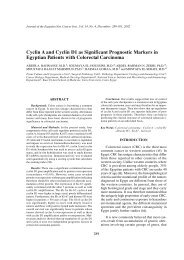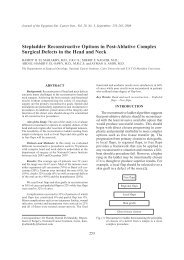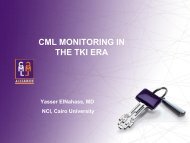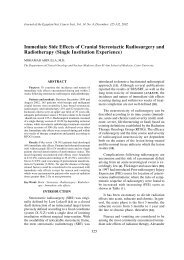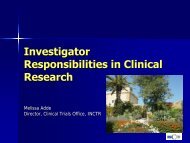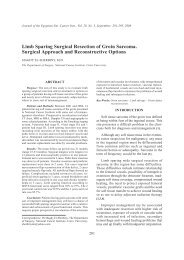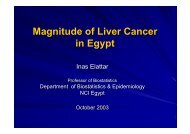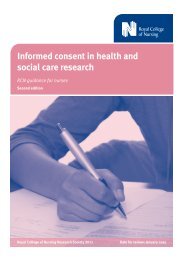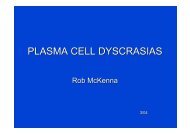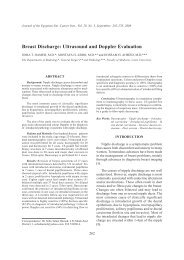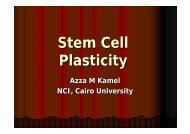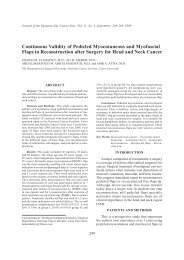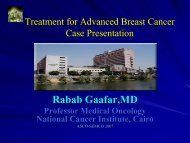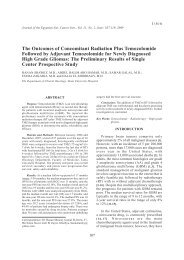Gastrointestinal Stromal Tumors (GIST) of the Stomach ... - NCI
Gastrointestinal Stromal Tumors (GIST) of the Stomach ... - NCI
Gastrointestinal Stromal Tumors (GIST) of the Stomach ... - NCI
You also want an ePaper? Increase the reach of your titles
YUMPU automatically turns print PDFs into web optimized ePapers that Google loves.
Journal <strong>of</strong> <strong>the</strong> Egyptian Nat. Cancer Inst., Vol. 20, No. 1, March: 80-89, 2008<br />
<strong>Gastrointestinal</strong> <strong>Stromal</strong> <strong>Tumors</strong> (<strong>GIST</strong>) <strong>of</strong> <strong>the</strong> <strong>Stomach</strong>:<br />
Retrospective Experience with Surgical Resection at <strong>the</strong> National<br />
Cancer Institute<br />
SHERIF F. NAGUIB, M.D.; ASHRAF S. ZAGHLOUL, M.D. and HAMDY El MARAKBY, M.D.<br />
The Department <strong>of</strong> Surgical Oncology, National Cancer Institute.<br />
ABSTRACT<br />
Background: Gastric <strong>GIST</strong>s account for more than<br />
half <strong>of</strong> all gastrointestinal stromal tumors and represent<br />
less than 5% <strong>of</strong> all gastric tumors. The peak age for<br />
harboring <strong>GIST</strong> <strong>of</strong> <strong>the</strong> stomach is around 60 years and a<br />
slight male preponderance is reported. These tumors are<br />
identified by expression <strong>of</strong> CD117 or CD34 antigen.<br />
Symptoms at presentation usually include bleeding, abdominal<br />
pain or abdominal mass. Endoscopically, <strong>the</strong>y<br />
typically appear as a submucosal mass with or without<br />
ulceration and on CT scans an extragastric mass is usually<br />
seen. Complete surgical resection provides <strong>the</strong> only chance<br />
for cure, with only 1-2cm free margins needed. However,<br />
local recurrence and/or metastases supervene in almost<br />
half <strong>the</strong> patients treated with surgery alone, even when<br />
no gross residual is left. Thereby imatinib mesylate was<br />
advocated as an adjuvant to surgery, which appears to<br />
have improved disease-free and overall survival.<br />
Aim <strong>of</strong> <strong>the</strong> Work: The aim <strong>of</strong> this work was to assess<br />
clinico-pathological features <strong>of</strong> gastrointestinal stromal<br />
tumors (<strong>GIST</strong>) <strong>of</strong> <strong>the</strong> stomach and to appraise <strong>the</strong> results<br />
<strong>of</strong> treatment by surgery in patients treated at <strong>the</strong> National<br />
Cancer Institute (<strong>NCI</strong>) <strong>of</strong> Cairo between January 2002<br />
and December 2007.<br />
Patients and Methods: Nineteen patients with histologically<br />
and immuno-histochemically proven <strong>GIST</strong> <strong>of</strong><br />
<strong>the</strong> stomach were treated by surgery at <strong>the</strong> <strong>NCI</strong> during<br />
<strong>the</strong> 6-year study period. Preoperative assessment included<br />
detailed history, clinical examination, full laboratory tests,<br />
endoscopy, abdominal ultrasound and CT. General medical<br />
assessment included chest X-ray, ECG and echocardiography.<br />
Results: The patients’ age ranged from 26 to 77 years<br />
with a median <strong>of</strong> 51 years. Obvious male/female preponderance<br />
was noticed (68.4% to 31.6%). <strong>Tumors</strong> were<br />
located at <strong>the</strong> upper 1/3 in 42.1%, at <strong>the</strong> middle 1/3 in<br />
31.6% and at <strong>the</strong> lower 1/3 in 26.3%. The most common<br />
clinical presentation was related to bleeding (hematemesis,<br />
melena or anaemia) and was seen in 63.2%. No tumors<br />
Correspondence: Dr. Sherif Naguib, 7 B El Bostan St.,<br />
Tahrir Square, Cairo, Egypt, ashrafsz@hotmail.com<br />
were labeled as very low or low risk while <strong>the</strong>re were<br />
52.6% intermediate risk and 47.4% high risk. Wedge<br />
resection was carried out in 15.8%, partial gastrectomy<br />
in 37.8%, total gastrectomy in 5.2%, extended gastric<br />
resection in 21.1% and only biopsy in 5.2%. Lymphadenectomy<br />
was carried out in 5/19 patients to reveal negative<br />
lymph nodes in all five. Complications occurred in 73.7%<br />
<strong>of</strong> patients and only 1 case <strong>of</strong> early postoperative mortality<br />
was recorded. Two patients were lost to follow-up. The<br />
remaining 16 patients were followed-up for a period<br />
ranging from 6-34 months with a mean <strong>of</strong> 19.5±5.6 months<br />
and <strong>the</strong>y were all alive by <strong>the</strong> end <strong>of</strong> <strong>the</strong> study, 10 were<br />
free <strong>of</strong> disease and 6 showed disease recurrence.<br />
Conclusion: Gastric <strong>GIST</strong> can present with vague<br />
and non specific clinical picture. Therefore, thorough<br />
clinical and radiological evaluation and preoperative<br />
endoscopy and biopsy are essential to reach <strong>the</strong> diagnosis<br />
and to assess <strong>the</strong> risk for metastasis. The clinical outcome<br />
<strong>of</strong> <strong>the</strong>se tumors is influenced by completeness <strong>of</strong> tumor<br />
extirpation while avoiding tumor rupture, and by <strong>the</strong> tumor<br />
malignant potential. Accordingly for tumors with adverse<br />
factors, multimodal <strong>the</strong>rapy with adjuvant imatinib or one<br />
<strong>of</strong> its successors should be considered in order to improve<br />
overall and disease-free survival.<br />
Key Words: Gastric – <strong>GIST</strong> – Surgical treatment.<br />
INTRODUCTION<br />
The term <strong>GIST</strong> was first introduced in 1983<br />
by Mazur and Clark [1] to describe non-epi<strong>the</strong>lial<br />
tumors <strong>of</strong> <strong>the</strong> GI tract that are thought to arise<br />
from <strong>the</strong> interstitial cells <strong>of</strong> Cajal (ICC) which<br />
are components <strong>of</strong> <strong>the</strong> intestinal autonomic<br />
nervous system and that act as pacemakers<br />
regulating peristalsis [2]. In 1998, Hirota and<br />
colleagues [3] demonstrated gain-<strong>of</strong>-function<br />
mutations <strong>of</strong> <strong>the</strong> KIT proto-oncogene in <strong>the</strong> vast<br />
majority <strong>of</strong> <strong>GIST</strong>s. This lead to identification<br />
<strong>of</strong> <strong>the</strong>se tumors by <strong>the</strong> universal expression<br />
(~95%) <strong>of</strong> <strong>the</strong> CD117 antigen, part <strong>of</strong> <strong>the</strong> KIT<br />
receptor. About 60% to 70% <strong>of</strong> <strong>GIST</strong>s may show<br />
immuno-positivity for CD34 which is more<br />
common in <strong>the</strong> colorectum and esophagus [4].<br />
80
<strong>Gastrointestinal</strong> <strong>Stromal</strong> <strong>Tumors</strong> (<strong>GIST</strong>) <strong>of</strong> <strong>the</strong> <strong>Stomach</strong><br />
<strong>Gastrointestinal</strong> stromal tumors (<strong>GIST</strong>s) are<br />
<strong>the</strong> most common mesenchymal tumors <strong>of</strong> <strong>the</strong><br />
GI tract [4] with an annual incidence in <strong>the</strong><br />
United States ranging between 10-20 per million<br />
[5,6]. In Egypt <strong>the</strong> relative incidence reported<br />
by <strong>the</strong> National Cancer Institute is 2.5% <strong>of</strong> all<br />
GI tumors and 0.3% <strong>of</strong> all malignancies [7].<br />
These tumors can arise throughout <strong>the</strong> GI tract,<br />
and <strong>the</strong> stomach is <strong>the</strong> most common site, accounting<br />
for 50%-70% <strong>of</strong> <strong>GIST</strong>s [5,6,8] but<br />
representing
82<br />
abdominal dissemination <strong>of</strong> tumor cells with<br />
subsequent high risk <strong>of</strong> tumor recurrence [27].<br />
Therefore, intra-abdominal open biopsy is discouraged<br />
by most experts because <strong>of</strong> <strong>the</strong> risk<br />
<strong>of</strong> tumor spillage [20].<br />
Lymphadenectomy is not routinely required<br />
since lymph node involvement is rare with <strong>GIST</strong><br />
[13]. Never<strong>the</strong>less, LN dissection should be considered<br />
for patients with any suspicion <strong>of</strong> nodal<br />
metastasis [28].<br />
Until <strong>the</strong> year 2000, chemo<strong>the</strong>rapy and radiation<br />
treatments had no proven effective role<br />
in <strong>the</strong> treatment <strong>of</strong> advanced disease and <strong>the</strong><br />
only known ''effective'' treatment for metastatic<br />
<strong>GIST</strong>s was surgery [29]. However, disease recurred<br />
in all patients after a very short diseasefree<br />
interval and 5 and 10-year survival rates<br />
after potentially curative surgery alone were<br />
reported to be 32-78% and 19-63% respectively<br />
[13,30-33].<br />
Imatinib mesylate was recently introduced<br />
as an integral component <strong>of</strong> <strong>GIST</strong> treatment. It<br />
is a potent and specific inhibitor <strong>of</strong> <strong>the</strong> KITprotein<br />
tyrosine-kinase and it has been approved<br />
for <strong>the</strong> treatment <strong>of</strong> KIT (CD 117)-positive<br />
irresectable or metastatic <strong>GIST</strong>s. However, <strong>the</strong><br />
use <strong>of</strong> adjuvant imatinib after complete resection<br />
<strong>of</strong> primary <strong>GIST</strong> is still being evaluated [34].<br />
PATIENTS AND METHODS<br />
Patients:<br />
Nineteen patients with primary or recurrent<br />
gastric stromal tumor (<strong>GIST</strong>) were operated<br />
upon at <strong>the</strong> department <strong>of</strong> surgery <strong>of</strong> <strong>the</strong> National<br />
Cancer Institute <strong>of</strong> Cairo in <strong>the</strong> period between<br />
January 2002 and December 2007. This retrospective<br />
descriptive clinical study was based<br />
on studying <strong>the</strong> patients’ data retrieved from<br />
<strong>the</strong>ir medical records over that 6-year period.<br />
The studied parameters included patients'<br />
demographic characteristics such as age, gender<br />
and occupation as recorded in patient’s files<br />
(Table 1). Clinical data retrieved from patients'<br />
records included symptoms, tumor’s location,<br />
size and histology (Table 2). Information regarding<br />
type <strong>of</strong> operation, resection margin and<br />
lymph node status (Table 3).<br />
Preoperative assessment included CBC, liver<br />
and kidney function tests, chest X-ray and cardiac<br />
function assessment. Preoperative diagnosis<br />
Sherif F. Naguib, et al.<br />
was based on endoscopic, ultrasound (US) or<br />
CT imaging (Fig. 1) and guided biopsy; while<br />
metastatic work up included abdominal US<br />
and/or CT, bone scan and chest X-ray.<br />
Evaluation:<br />
All tumors were reviewed by experienced<br />
pathologists for histological confirmation <strong>of</strong><br />
<strong>the</strong> diagnosis <strong>of</strong> <strong>GIST</strong> and evaluation <strong>of</strong> <strong>the</strong><br />
morphological and immuno-histochemical characteristics.<br />
All included tumors were c-KIT<br />
(CD117) or (CD34) positive. Tumor size was<br />
evaluated on fresh specimens. The mitotic rate<br />
was assessed by counting <strong>the</strong> number <strong>of</strong> mitosis<br />
per 50 high power fields (HPF) in all patients.<br />
The tumors were classified according to <strong>the</strong><br />
risk assessment suggested by Fletcher et al. [15]<br />
into one <strong>of</strong> 4 categories: very low, low, intermediate<br />
or high risk.<br />
Treatment:<br />
Different types <strong>of</strong> gastric resections were<br />
carried out and <strong>the</strong>y were classified into <strong>the</strong><br />
following categories; RO was defined as complete<br />
resection. R1 included complete resection<br />
<strong>of</strong> accompanying peritoneal seeding, omental<br />
or liver deposits. R2 entailed leaving gross<br />
residual [35]. Imatinib mesylate was administered<br />
to patients having distant metastases at diagnosis,<br />
undergoing an incomplete (R2) resection<br />
or experiencing recurrence after surgical resection.<br />
Evaluation <strong>of</strong> treatment results:<br />
All patients were carefully followed-up clinically<br />
at three-monthly intervals and endoscopically,<br />
by ultrasound and by CT at six-monthly<br />
intervals. The follow-up period was calculated<br />
from <strong>the</strong> date <strong>of</strong> surgery to <strong>the</strong> last month <strong>of</strong><br />
follow-up, tumor recurrence or death. Postoperative<br />
hospital stay, complications, site and<br />
time <strong>of</strong> recurrence and survival were also noted<br />
(Table 4).<br />
RESULTS<br />
Nineteen patients were considered eligible<br />
for this study. They were 13 males and 6 females<br />
and <strong>the</strong>ir ages ranged from 26 years to 77 years<br />
(median: 51 years). Their tumor size ranged<br />
from 5 to 50 cm with a median size <strong>of</strong> 18.5 cm.<br />
<strong>Tumors</strong> measured 5-10 cm in 15 patients and<br />
10-50 cm in 4 patients. The mitotic counts <strong>of</strong><br />
<strong>the</strong> tumors were found to be 10/50 HPF
<strong>Gastrointestinal</strong> <strong>Stromal</strong> <strong>Tumors</strong> (<strong>GIST</strong>) <strong>of</strong> <strong>the</strong> <strong>Stomach</strong><br />
in 3 cases. All included tumors were c-KIT<br />
(CD-117) positive (16 cases) or CD-34 positive<br />
(3 cases). The histological types <strong>of</strong> <strong>the</strong> tumors<br />
were Spindle cell type in 13 cases, Epi<strong>the</strong>lioid<br />
type in 2 cases, mixed type in 2 cases and<br />
unclassified in 2 cases. Patients were subdivided<br />
into 4 groups according to Fletcher’s risk assessment<br />
rules [15]. None were assigned to <strong>the</strong><br />
very low or to <strong>the</strong> low risk groups, 10 cases<br />
were labeled as intermediate and 9 cases fell in<br />
<strong>the</strong> high risk category (Table 1).<br />
All patients were symptomatic at presentation.<br />
The main presenting symptoms were abdominal<br />
pain in 10 patients, a palpable abdominal<br />
mass in 7 cases and gastrointestinal bleeding<br />
(hematemesis or melena) in 2 cases. In addition,<br />
10/19 patients were found anaemic with a Hemoglobin<br />
<strong>of</strong>
84<br />
Sherif F. Naguib, et al.<br />
3 cases with >10/50 mitoses per HPF, 2 patients<br />
(66.7%) developed recurrence one in <strong>the</strong> liver<br />
and <strong>the</strong> o<strong>the</strong>r both on <strong>the</strong> peritoneal surface and<br />
liver (Fig. 7 and Table 2).<br />
12<br />
10<br />
8<br />
No recurrence<br />
Recurrent cases<br />
6<br />
4<br />
2<br />
0<br />
R0 R1 R2<br />
Fig. (4): Recurrence in relation to type (R) <strong>of</strong> gastric<br />
resection.<br />
Fig. (1): Abdominal CT showing exophytic <strong>GIST</strong> arising<br />
from gastric body.<br />
12<br />
10<br />
No recurrence<br />
Recurrent cases<br />
8<br />
6<br />
4<br />
2<br />
Fig. (2): Same case <strong>of</strong> exophytic gastric <strong>GIST</strong> at laparotomy.<br />
0<br />
12<br />
10<br />
No rupture With rupture<br />
Fig. (5): Recurrence in relation to tumor rupture.<br />
No recurrence<br />
Recurrent cases<br />
8<br />
6<br />
4<br />
2<br />
Fig. (3): Same tumor after wedge gastric resection with<br />
grossly free margin from <strong>Stomach</strong> wall.<br />
0<br />
10cm<br />
Fig. (6): Recurrence in relation to size <strong>of</strong> tumor.
<strong>Gastrointestinal</strong> <strong>Stromal</strong> <strong>Tumors</strong> (<strong>GIST</strong>) <strong>of</strong> <strong>the</strong> <strong>Stomach</strong><br />
85<br />
10<br />
8<br />
6<br />
4<br />
2<br />
0<br />
10/50<br />
No recurrence<br />
Recurrent cases<br />
Fig. (7): Recurrence in relation to mitotic count (No <strong>of</strong><br />
mitoses/50 HPF).<br />
Table (1): Demographic features <strong>of</strong> 19 patients with gastric<br />
<strong>GIST</strong>.<br />
Gender:<br />
Male<br />
Female<br />
Age (years):<br />
21-30<br />
31-40<br />
41-50<br />
51-60<br />
61-70<br />
71-80<br />
Table (2): Clinico-pathological features <strong>of</strong> tumors.<br />
Site:<br />
Upper1/3<br />
Middle 1/3<br />
Lower1/3<br />
Size:<br />
5-10cm<br />
10-50cm<br />
Mitotic count:<br />
10/50 HPF<br />
Histology:<br />
Spindle cell<br />
Epi<strong>the</strong>lioid cell<br />
Mixed cell<br />
Unclassified<br />
Malignant potential:<br />
Very low<br />
Low<br />
Intermediate<br />
High<br />
HPF: High power field.<br />
Number <strong>of</strong> patients<br />
13<br />
6<br />
1<br />
2<br />
5<br />
6<br />
3<br />
2<br />
Number <strong>of</strong> patients<br />
8<br />
6<br />
5<br />
15<br />
4<br />
9<br />
7<br />
3<br />
13<br />
2<br />
2<br />
2<br />
0<br />
0<br />
10<br />
9<br />
%<br />
68.4<br />
31.5<br />
5.3<br />
10.5<br />
26.3<br />
31.5<br />
15.8<br />
10.5<br />
%<br />
42.1<br />
31.5<br />
26.3<br />
78.9<br />
21.1<br />
47.4<br />
36.8<br />
15.8<br />
68.5<br />
10.5<br />
10.5<br />
10.5<br />
0<br />
0<br />
52.6<br />
47.4<br />
Table (3): Surgical treatment and outcome in 19 patients<br />
with gastric <strong>GIST</strong>.<br />
Surgical intervention:<br />
Wedge Gastrectomy<br />
Partial Gastrectomy*<br />
Total Gastrectomy<br />
Extended Gastrectomy<br />
Excision <strong>of</strong> local recurrence<br />
Exploration & Biopsy<br />
Microscopic margin**:<br />
Free<br />
Close<br />
Involved<br />
* 1/7 patients underwent laparoscopic antrectomy.<br />
** Only 18 patients were included because 1 patient was irresectable<br />
and only wedge biopsy was taken.<br />
DISCUSSION<br />
Number<br />
<strong>of</strong> patients<br />
Gastric <strong>GIST</strong>s account for more than half<br />
<strong>of</strong> all gastrointestinal stromal tumors and represent<br />
less than 5% <strong>of</strong> all gastric tumors. These<br />
tumors are identified by expression <strong>of</strong> CD117<br />
antigen which is a part <strong>of</strong> KIT receptor. Symptoms<br />
at presentation usually include bleeding<br />
and anaemia, abdominal pain and/or abdominal<br />
mass. Complete surgical resection provides <strong>the</strong><br />
only chance for cure, with only 1-2 cm free<br />
margins needed. Never<strong>the</strong>less, local recurrence<br />
3<br />
7<br />
1<br />
4<br />
3<br />
1<br />
16<br />
1<br />
1<br />
%<br />
15.8<br />
36.8<br />
5.3<br />
21.1<br />
15.8<br />
5.3<br />
88.9<br />
5.6<br />
5.6<br />
Table (4): Results <strong>of</strong> treatment in 19 patients with gastric<br />
<strong>GIST</strong>.<br />
Complications:<br />
Chest infection<br />
Pulmonary embolism<br />
Anastomotic leakage<br />
Incisional hernia<br />
Recurrence*:<br />
Site<br />
Local<br />
Liver<br />
Both<br />
Time (months):<br />
0-6<br />
7-12<br />
13-18<br />
19-24<br />
Number<br />
<strong>of</strong> patients<br />
* Only 16 patients were included because 1 patient died on D6<br />
and 2 patients were lost to follow-up.<br />
5<br />
1<br />
4<br />
4<br />
2<br />
3<br />
1<br />
0<br />
2<br />
1<br />
3<br />
%<br />
26.3<br />
5.3<br />
21.1<br />
21.1<br />
12.5<br />
18.8<br />
6.3<br />
0<br />
12.5<br />
6.3<br />
18.8
86<br />
and/or metastases supervene in almost half <strong>the</strong><br />
patients treated with surgery alone, even when<br />
no gross residual is left [4,5].<br />
The present study reviewed <strong>the</strong> clinicopathological<br />
features <strong>of</strong> gastrointestinal stromal<br />
tumors (<strong>GIST</strong>) <strong>of</strong> <strong>the</strong> stomach in 19 patients<br />
treated surgically at <strong>the</strong> National Cancer Institute<br />
<strong>of</strong> Cairo during <strong>the</strong> 6-year period between January<br />
2002 and December 2007. We also tried<br />
to appraise <strong>the</strong> results <strong>of</strong> treatment in relation<br />
to patients’ criteria, tumors’ characteristics and<br />
extent <strong>of</strong> surgery and <strong>the</strong>ir effect on disease<br />
recurrence.<br />
Sex distribution among our patients showed<br />
a clear male predominance (2.2: 1) compared<br />
to most reported series which found no appreciable<br />
sex difference in adults [8,10,11]. This<br />
observation needs to be studied more thoroughly<br />
in a larger series.<br />
Tumor location was found in <strong>the</strong> upper 1/3<br />
<strong>of</strong> <strong>the</strong> stomach in 8 cases (42.1%), <strong>the</strong> middle<br />
1/3 in 6 cases (31.5%) and <strong>the</strong> lower 1/3 in 5<br />
cases (26.3%). These figures correlate with<br />
o<strong>the</strong>r studies reporting that gastric <strong>GIST</strong> usually<br />
affects <strong>the</strong> proximal stomach in over two thirds<br />
<strong>of</strong> cases [10].<br />
All our patients were symptomatic at presentation.<br />
This could be explained by <strong>the</strong> large<br />
size <strong>of</strong> our tumors ranging from 5-50 cm (median:<br />
18.5 cm). In contrast, most western studies<br />
reported that only 50-70% <strong>of</strong> patients are symptomatic<br />
[8,11,36]. Three studies done one at Mayo<br />
clinic [36], ano<strong>the</strong>r at Cleveland [37] and a third<br />
at Irvine [38] in <strong>the</strong> USA, reported that <strong>the</strong>ir<br />
tumors’ size ranged from (1.5 to 7.0 cm), (0.5<br />
to 10.5 cm) and (2.8 to 7.1 cm) respectively. In<br />
<strong>the</strong> first study, not a single patient presented<br />
with symptoms. Kindblom [14] found that symptomatic<br />
<strong>GIST</strong>s tend to be larger (average size<br />
<strong>of</strong> 6 cm) versus 2 cm for asymptomatic <strong>GIST</strong>s.<br />
In a study published by Miettinen and colleagues<br />
[8], 54.4% <strong>of</strong> patients presented with symptoms<br />
related to GI bleeding (most commonly anemia)<br />
and a smaller fraction <strong>of</strong> patients (16.8%) presented<br />
with upper abdominal pain. Slightly<br />
higher figures were found in our study where<br />
63% <strong>of</strong> <strong>the</strong> patients presented with symptoms<br />
related to bleeding such as hematemesis, melena<br />
or anaemia. This could probably be explained<br />
by more frequent mucosal ulceration caused by<br />
our larger tumors.<br />
Sherif F. Naguib, et al.<br />
Upon histological examination <strong>of</strong> <strong>the</strong> specimens,<br />
68.5% <strong>of</strong> <strong>the</strong> tumors, were found to be<br />
spindle cell, 10.5% were epi<strong>the</strong>lioid, 10.5%<br />
were mixed (spindle and epi<strong>the</strong>lioid) and 10.5%<br />
were unclassified. This compares favorably<br />
with <strong>the</strong> described incidence in o<strong>the</strong>r studies.<br />
Levy et al., reported that 20-30% <strong>of</strong> gastric<br />
<strong>GIST</strong>s have epi<strong>the</strong>lioid morphology and that<br />
some show both elements [39]. In this study, no<br />
cases were assigned to <strong>the</strong> very low or to <strong>the</strong><br />
low risk groups, while 52.6% <strong>of</strong> <strong>the</strong> cases were<br />
labeled as intermediate risk and 47.4% as high<br />
risk. Our cases showed higher risk when compared<br />
to o<strong>the</strong>r studies dealing with gastric <strong>GIST</strong>.<br />
Berindoague et al. [9] reported <strong>the</strong> low, intermediate<br />
and high risk groups to account for 44.4%,<br />
33.3% and 22.2% respectively. This could also<br />
be due to <strong>the</strong> large tumor size at presentation<br />
in our cases.<br />
It has been reported that 10%-47% <strong>of</strong> patients<br />
with <strong>GIST</strong> harbor distant metastases at<br />
presentation [13,35]. In this study, only 2/19<br />
patients (10.5%) presented with metastatic disease.<br />
This low incidence in association with<br />
high prevalence <strong>of</strong> high risk cases needs to be<br />
fur<strong>the</strong>r explored. Never<strong>the</strong>less, relative metastatic<br />
distribution was close to o<strong>the</strong>r reports<br />
[13,33,35,40] since it involved <strong>the</strong> liver in 5.3%<br />
and <strong>the</strong> omentum in 5.3%.<br />
Five <strong>of</strong> our patients underwent nodal dissection<br />
but no lymph node metastases were histologically<br />
found in any <strong>of</strong> <strong>the</strong>m. Again, this<br />
finding compares favorably with o<strong>the</strong>r studies<br />
[13,20,41] where positive nodes were rarely reported.<br />
Our results consolidate <strong>the</strong> general<br />
consensus that lymphadenectomy is warranted<br />
only when evident nodal involvement is found<br />
[20].<br />
Most studies on <strong>GIST</strong> advocate that vital<br />
structures such as <strong>the</strong> stomach should not be<br />
sacrificed if grossly free margins can be<br />
achieved, since <strong>the</strong> status <strong>of</strong> microscopic margins<br />
does not seem to affect survival [13,42]. A<br />
wedge resection <strong>of</strong> <strong>the</strong> stomach with tumor-free<br />
margins is satisfactory in most gastric <strong>GIST</strong>s<br />
while gastrectomy is reserved for tumors involving<br />
<strong>the</strong> pylorus or <strong>the</strong> esophago-gastric<br />
junction [40]. In accordance with this principle<br />
<strong>of</strong> organ preservation, total gastrectomy was<br />
undertaken, in this study in only one case (5.2%)<br />
and this was due to <strong>the</strong> large size <strong>of</strong> <strong>the</strong> tumor<br />
involving approximately <strong>the</strong> whole stomach.
<strong>Gastrointestinal</strong> <strong>Stromal</strong> <strong>Tumors</strong> (<strong>GIST</strong>) <strong>of</strong> <strong>the</strong> <strong>Stomach</strong><br />
Microscopic margins were infiltrated in 1 case<br />
and close in 1 case. The former patient developed<br />
local tumor bed recurrence after 8 months<br />
while <strong>the</strong> latter stayed free for 13 months (till<br />
<strong>the</strong> end <strong>of</strong> <strong>the</strong> study). Among <strong>the</strong> remaining 13<br />
patients with free surgical margins, only 2 patients<br />
developed local recurrence. This matches<br />
with <strong>the</strong> finding by Gold and DeMatteo [43] that<br />
<strong>the</strong> presence <strong>of</strong> residual tumor is significantly<br />
related to early recurrence and short survival.<br />
Similarly, Pierie et al. [42] and DeMatteo et al.<br />
[13] reported a significantly longer 5 year survival<br />
rate when <strong>GIST</strong>s were completely removed<br />
(42% and 54% respectively, versus 9% for<br />
incomplete removal according to <strong>the</strong> former<br />
study).<br />
Treatment failures are known to affect almost<br />
half <strong>of</strong> <strong>GIST</strong> patients treated by surgery alone<br />
[4,5] and tend to be found in <strong>the</strong> liver in 65%,<br />
<strong>the</strong> peritoneal surfaces in 50% and in both in<br />
about 20% [13]. In agreement with <strong>the</strong>se findings,<br />
tumor recurrence occurred in 6/16 <strong>of</strong> our<br />
followed patients (37.5%). It was in <strong>the</strong> liver<br />
in 50%, local on <strong>the</strong> peritoneal surface in 33.3%<br />
and it occurred synchronously in both in 16.7%.<br />
We probably had slightly smaller figures because<br />
<strong>of</strong> our smaller number <strong>of</strong> patients and shorter<br />
follow-up period. On <strong>the</strong> o<strong>the</strong>r hand, this study<br />
involved only gastric <strong>GIST</strong>s which have been<br />
reported to follow a less aggressive course<br />
compared to small bowel tumors <strong>of</strong> <strong>the</strong> same<br />
size [39,44].<br />
Tumor rupture occurred in 6/19 cases.<br />
Among <strong>the</strong>se 66.7% developed disease recurrence<br />
(Fig. 5). This finding confirms <strong>the</strong> recommendation<br />
<strong>of</strong> Mochizuki et al. [27] to avoid<br />
tumor rupture since it was associated with intraabdominal<br />
dissemination <strong>of</strong> tumor cells and<br />
subsequent high risk <strong>of</strong> local tumor recurrence.<br />
Lillemoe et al. [44] found that recurrence<br />
was predicted by tumor size as well as mitotic<br />
count. Comparable findings were found by Boni<br />
et al. [45]. Our results are in accordance with<br />
<strong>the</strong>se findings. In <strong>the</strong> present study, patients<br />
with tumors >10 cm in diameter developed<br />
disease recurrence more frequently than those<br />
with smaller tumors measuring
88<br />
patients treated with surgery alone, hence, multimodal<br />
<strong>the</strong>rapy warrants consideration for tumors<br />
with adverse factors. It is thought that<br />
larger prospective randomized studies are needed<br />
to precisely identify significant prognostic<br />
factors and to clarify whe<strong>the</strong>r adjuvant treatment<br />
with imatinib or one <strong>of</strong> its more recent successors<br />
can improve overall and disease-free survival<br />
in high risk <strong>GIST</strong>s.<br />
REFERENCES<br />
1- Mazur MT, Clark HB, Hashimoto K, Nishida T,<br />
Ishiguro S, et al. Gastric stromal tumors: Reappraisal<br />
<strong>of</strong> histogenesis. Am J Surg Path. 1983, 7: 517-9.<br />
2- Graadt van Roggen JF, van Velthuysen ML, Hogendoorn<br />
PC. The histopathological differential diagnosis<br />
<strong>of</strong> gastrointestinal stromal tumors. J Clin Pathol. 2001,<br />
54: 96-102.<br />
3- Hirota S, Isozaki K, Moriyama Y, Hashimoto K,<br />
Nishida T, et al. Gain <strong>of</strong> function mutations <strong>of</strong> c-kit<br />
in human gastrointestinal stromal tumors. Science.<br />
1998, 279: 577-80.<br />
4- Miettinen M, Majidi M, Lasota J. Pathology and<br />
diagnostic criteria <strong>of</strong> gastrointestinal stromal tumors<br />
(<strong>GIST</strong>s); a review. Eur J Cancer. 2002, 38 (5): 39-51.<br />
5- Corless C, Fletcher J, Heinrich M. Biology <strong>of</strong> gastrointestinal<br />
stromal tumors. J Clin Oncol. 2004, 18:<br />
3813-25.<br />
6- Miettinen M, Lasota. <strong>Gastrointestinal</strong> stromal tumorsdefinition,<br />
clinical, histological, immunohistochemical<br />
and molecular genetic features and differential diagnosis.<br />
Virchows Arch. 2001, 438 (1): 1-12.<br />
7- Mokhtar N, Gouda I, Adel I. Digestive system malignancies.<br />
In Cancer Pathology Registry (2003-2004),<br />
p. 67. <strong>NCI</strong>, Cairo University.<br />
8- Miettinen M, Sobin LH, Lasota J. <strong>Gastrointestinal</strong><br />
stromal tumors <strong>of</strong> <strong>the</strong> stomach: A clinicopathologic,<br />
immunohistochemical and molecular genetic study<br />
<strong>of</strong> 1765 cases with long-term follow-up. Am J Surg<br />
Pathol. 2005, 29: 52-68.<br />
9- Berindoague R, Targarona EM, Feliu X, Artigas V,<br />
Balague C, et al. Laparoscopic resection <strong>of</strong> clinically<br />
suspected gastric stromal tumors. Surgical innovation.<br />
2006, 13 (4): 231-7.<br />
10- Mat<strong>the</strong>ws BD, Joels CS, Kercher KW, Heniford BT.<br />
<strong>Gastrointestinal</strong> stromal tumors <strong>of</strong> <strong>the</strong> stomach. Minerva<br />
Chir. 2004, 59: 219-31.<br />
11- Nilsson B, Bümming P, Meis-Kindblom JM, Odén A,<br />
Dortok A, et al. <strong>Gastrointestinal</strong> stromal tumors: The<br />
incidence, prevalence, clinical course and prognostication<br />
in <strong>the</strong> pre-imatinib mesylate era-a populationbased<br />
study in western Sweden. Cancer. 2005, 103:<br />
821-9.<br />
12- Debiec-Rychter M, Wasag B, Stul M, De Wever I,<br />
Van Oosterom A, et al. <strong>Gastrointestinal</strong> stromal tumors<br />
Sherif F. Naguib, et al.<br />
(<strong>GIST</strong>s) negative for KIT (CD117 antigen) immunoreactivity.<br />
J Pathol. 2004, 202: 430-8.<br />
13- DeMatteo RP, Lewis JJ, Leung D, Mudan SS, Woodruff<br />
JM, Brennan MF. Two hundred gastrointestinal stromal<br />
tumors: Recurrence patterns and prognostic factors<br />
for survival. Ann Surg. 2000, 231: 51-8.<br />
14- Kindblom LG. <strong>Gastrointestinal</strong> stromal tumors; diagnosis,<br />
epidemiology, prognosis. ASCO Annual Meeting,<br />
Chicago. 2003.<br />
15- Fletcher CD, Berman JJ, Corless C, Gorstein F, Lasota<br />
J, et al. Diagnosis <strong>of</strong> gastrointestinal stromal tumors:<br />
A consensus approach. Hum Pathol. 2002, 33: 459-<br />
65.<br />
16- Pannu HK, Hruban RH, Fishman EK. CT <strong>of</strong> gastric<br />
leiomyosarcoma: Patterns <strong>of</strong> involvement. AJR Am<br />
J Roentgenol. 1999 Aug, 173 (2): 369-73.<br />
17- Rossi CR, Mocellin S, mencarelli R, Foletto M, Pilati<br />
P, et al. <strong>Gastrointestinal</strong> stromal tumors, from a surgical<br />
to a molecular approach. Int J Cancer. 2003, 107:<br />
171-6.<br />
18- Bertagnolli MM. <strong>Gastrointestinal</strong> stromal tumors in:<br />
Maingot Abdominal Operation, 11 th ed. Ed. Zinner<br />
MG and Ashley WS. Pub Mac Graw Hill and Co.<br />
2007, p 439-51.<br />
19- Rader AE, Avery A, Wait CL, McGreevey LS, Faigel<br />
D, Heinrich MC. Fine needle aspiration biopsy diagnosis<br />
<strong>of</strong> gastrointestinal stromal tumors using morphology,<br />
immunohistochemistry and mutational analysis<br />
<strong>of</strong> c-kit. Cancer. 2001, 93: 269-75.<br />
20- Blay JY, Bonvalot S, Casali P, Choi H, Debiec-Richter<br />
M, et al. <strong>GIST</strong> consensus meeting panelists: Consensus<br />
meeting for <strong>the</strong> management <strong>of</strong> gastrointestinal stromal<br />
tumors. Report <strong>of</strong> <strong>the</strong> <strong>GIST</strong> consensus conference <strong>of</strong><br />
20-21 March 2004, under <strong>the</strong> hospices <strong>of</strong> ESMO. Ann<br />
Oncol. 2005, 16: 566-78.<br />
21- Heinrich MC, Corless CL. Gastric GI stromal tumors<br />
(<strong>GIST</strong>s): The role <strong>of</strong> surgery in <strong>the</strong> era <strong>of</strong> targeted<br />
<strong>the</strong>rapy. J Surg Oncol. 2005, 90: 195-207; discussion<br />
207.<br />
22- Mat<strong>the</strong>ws BD, Walsh RM, Kercher KW, Sing RF,<br />
Pratt BL, et al. Laparoscopic Vs open resection <strong>of</strong><br />
gastric stromal tumors. Surg Endoc. 2002, 16: 803-<br />
7.<br />
23- Demetri GD, Blanke CD. NCCN Task Force Report.<br />
Optimal management <strong>of</strong> patients with gastrointestinal<br />
stromal tumors (<strong>GIST</strong>): Expansion and update <strong>of</strong><br />
NCCN clinical guidelines. J Natl Comp Cancer Network.<br />
2004, 2 (Suppl): 1-26.<br />
24- Fujimoto Y, Nakanishi Y, Yoshimura K, Shimoda T,<br />
et al. Clinicopathologic study <strong>of</strong> primary malignant<br />
gastrointestinal stromal tumors <strong>of</strong> <strong>the</strong> stromach, with<br />
special reference <strong>of</strong> prognostic factors: Analysis <strong>of</strong><br />
results in 140 surgically resected patients. Gastric<br />
Cancer. 2003, 6: 39-48.<br />
25- Hohenberger P, Wardelmann E. Surgical considerations<br />
for gastrointestinal stroma tumor. Chirurg. 2006, 77:<br />
33-40.
<strong>Gastrointestinal</strong> <strong>Stromal</strong> <strong>Tumors</strong> (<strong>GIST</strong>) <strong>of</strong> <strong>the</strong> <strong>Stomach</strong><br />
89<br />
26- Cueto J, Vasqez-Frias JA, Castaneda-Leeder P, Baquera-Heredia<br />
J, Weber-Sanchez A. Laparoscopic-assisted<br />
resection <strong>of</strong> a bleeding gastrointestinal stromal tumor.<br />
JSLS. 1999, 3: 225-8.<br />
27- Mochizuki Y, Kodera Y, Ito S, Yamamura Y, Kanemitsu<br />
Y, et al. Treatment and risk factors for recurrence after<br />
curative resection <strong>of</strong> gastrointestinal stromal tumors<br />
<strong>of</strong> <strong>the</strong> stomach. World J Surg. 2004, 28: 870-5.<br />
28- Canda AE, Ozsoy Y, Nalbant OA, Sagol O. <strong>Gastrointestinal</strong><br />
stromal tumor <strong>of</strong> <strong>the</strong> stomach with lymph node<br />
metastasis. World J Surg Oncol. 2008, 6: 97-103.<br />
29- Dematteo RP, Heinrich MC, El-Rifai WM, Demetri<br />
G. Clinical management <strong>of</strong> astrointestinal stromal<br />
tumors: Before and after STI-571. Hum Pathol. 2002,<br />
33: 466-477.<br />
30- Ng EH, Pollock RE, Munsell MF, Atkinson EN,<br />
Romsdahl MM. Prognostic factors influencing survival<br />
in gastrointestinal leiomyosarcomas. Implications for<br />
surgical management and staging. Ann Surg. 1992,<br />
215: 68-77.<br />
31- Ng EH, Pollock RE, Romsdahl MM. Prognostic implications<br />
<strong>of</strong> patterns <strong>of</strong> failure for gastrointestinal<br />
leiomyosarcomas. Cancer. 1992, 69: 1334-1341.<br />
32- Shiu MH, Farr GH, Papachristou DN, Hajdu SI.<br />
Myosarcomas <strong>of</strong> <strong>the</strong> stomach: Natural history, prognostic<br />
factors and management. Cancer. 1982, 49:<br />
177-187.<br />
33- McGrath PC, Neifield JP, Lawrence WJ, Kay S,<br />
Horsley JS, et al. <strong>Gastrointestinal</strong> sarcomas. Analysis<br />
<strong>of</strong> prognostic factors. Ann Surg. 1987, 206: 706-10.<br />
34- Berman J, O’Leary TH. <strong>Gastrointestinal</strong> stromal tumor<br />
workshop. Hum Pathol. 2001, 32: 578-82.<br />
35- An JY, Choi MG, Noh JH, Sohn TS, Kang WK, Park<br />
CK, Kim S. Gastric <strong>GIST</strong>: A single institutional retrospective<br />
experience with surgical treatment for<br />
primary disease. Eur J Surg Oncol. 2007 Oct, 33 (8):<br />
1030-5.<br />
36- Huguet KL, Rush RM Jr, Tessier DJ, Schlinkert RT,<br />
Hinder RA, et al. Laparoscopic gastric gastrointestinal<br />
stromal tumor resection: The mayo clinic experience.<br />
Arch Surg. 2008 Jun, 143 (6): 587-90.<br />
37- Walsh RM, Ponsky J, Brody F, Mat<strong>the</strong>ws BD, Heniford<br />
BT, et al. Combined endoscopic/laparoscopic intragastric<br />
resection <strong>of</strong> gastric stromal tumors. J Gastrointest<br />
Surg. 2003, 7: 386-92.<br />
38- Nguyen NT, Jim J, Nguyen A, Lee J, Chang K, et al.<br />
Laparoscopic resection <strong>of</strong> gastric stromal tumor: A<br />
tailored approach. Am Surg. 2003, 69: 946-50.<br />
39- Levy AD, Remonti HE, Thompson WM, Sobin LH,<br />
Miettinen M. <strong>Gastrointestinal</strong> stromal tumors: Radiologic<br />
features with pathologic correlation. Radiographics.<br />
2003, 23: 283-304.<br />
40- Bucher P, Villiger P, Egger JF, Buhler LH, Morel P.<br />
Management <strong>of</strong> gastrointestinal stromal tumors from<br />
diagnosis to treatment. Swiss Med Wkly. 2004, 134:<br />
145-53.<br />
41- Loong HHF. Gastro-intestinal stromal tumors: A<br />
review <strong>of</strong> current management options. Hong Kong<br />
Med J. 2007, 13: 61-5.<br />
42- Pierie JP, Choudry U, Muzikansky A, Yeap BY, Souba<br />
WW, et al. The effect <strong>of</strong> surgery and grade on outcome<br />
<strong>of</strong> gastrointestinal stromal tumors. Arch Surg. 2001,<br />
136: 383-9.<br />
43- Gold JS, DeMatteo RP. Combined surgical and molecular<br />
<strong>the</strong>rapy: The gastrointestinal stromal tumor<br />
model. Ann Surg. 2006 August, 244 (2): 176-184.<br />
44- Lillemoe KD, Efron DT. <strong>Gastrointestinal</strong> stromal<br />
tumors. In Current surgical <strong>the</strong>rapy. Cameron JL, Gery<br />
L, editor. Mosby Inc, USA. 2001, pp. 112-117.<br />
45- Boni L, Benevento A, Dionigi G, Rovera F, Dionigi<br />
R. Surgical resection for gastrointestinal stromal<br />
tumors (<strong>GIST</strong>): Experience on 25 patients. World J<br />
Surg Oncol. 2005, 3: 78.



